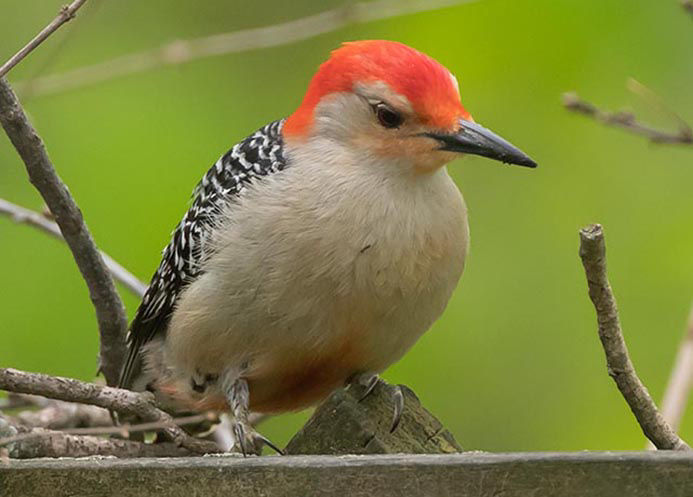Woodpeckers in Florida: Nature, Ecology, and Conservation
Woodpeckers in Florida: Nature, Ecology, and Conservation
Blog Article
Woodpeckers: A Comprehensive Guide to Recognizing These Distinct Birds
Woodpeckers, with their distinct behaviors and physical features, have long captivated the interest of ornithologists and nature enthusiasts alike. As we check out the detailed anatomy, varied varieties, and ecological relevance of woodpeckers, a deeper admiration for these distinct birds and the enigmas they hold unravels.

Woodpeckers' Drumming Habits
Woodpeckers display a rhythmic and precise drumming habits that serves various essential features in their day-to-day lives. This actions is mostly connected with communication, region protection, and foraging. The unique drumming sound is created by the quick pecking of their beaks against hard surface areas such as tree trunks, branches, or perhaps metal items.
Communication is an important aspect of woodpecker behavior, and drumming plays a substantial function in this process. Woodpeckers make use of drumming to establish their presence, draw in companions, and maintain call with their partners and spawn. The frequency, intensity, and period of drumming sequences share certain messages to various other woodpeckers in the location.
Along with communication, woodpeckers make use of drumming behavior for region defense. Woodpeckers in Florida. The loud and repetitive drumming functions as an advising to possible intruders, signifying that the area is currently claimed. By developing their territory via drumming, woodpeckers decrease the likelihood of conflicts over beneficial resources such as food and nesting websites
Furthermore, woodpeckers additionally employ drumming as a foraging strategy. The rhythmic pecking assists them situate bugs concealing below the bark of trees by producing vibrations that interrupt the victim's camouflage. This actions showcases the adaptability and ingenuity of woodpeckers in using their drumming skills for several vital purposes.
One-of-a-kind Adaptations for Tree Climbing
Having actually mastered the art of drumming to interact, safeguard territory, and forage, woodpeckers have progressed unique adaptations that facilitate their impressive climbing capabilities in their arboreal environments. One vital adaptation is their specific feet. Woodpeckers have zygodactyl feet, with 2 toes aiming forward and 2 toes aiming backward. This arrangement offers a solid grasp on the upright surface areas of trees, allowing them to cling effortlessly while foraging for insects or drumming. Furthermore, woodpeckers possess rigid tail plumes that work as a prop to sustain their bodies as they climb up. These tail plumes provide security and equilibrium, making it possible for woodpeckers to steer up tree trunks with accuracy and dexterity.
Additionally, woodpeckers have powerful neck muscle mass and an unique skull structure that help in their climbing up capacities. Their strong neck muscle mass allow them to quickly peck at tree bark without experiencing whiplash, while their thick skull and small mind work as shock absorbers, shielding them from the effect of news repeated drumming. These adaptations collectively enable woodpeckers to browse the upright world of trees with efficiency and poise.

Role of Woodpeckers in Environments
By foraging for bugs under the bark of trees, woodpeckers assist control bug populations, stopping break outs that might hurt the overall health of the forest. In addition, woodpeckers develop dental caries in trees that offer as vital nesting websites for a range of other bird species, promoting biodiversity within the ecological community.
Additionally, the drumming and articulations of woodpeckers play an essential duty in interaction and area establishment. These sounds not just offer Woodpeckers in Florida to attract friends yet likewise assist define borders in between different woodpecker territories, lowering problems and promoting a harmonious coexistence within the woodland neighborhood. Overall, the visibility of woodpeckers in woodland environments highlights their value as keystone species, affecting the dynamics and functioning of these habitats in multifaceted means.
Composition: Specialized Beaks and Feet
In the detailed web of woodland communities, the specialized beaks and feet of woodpeckers are crucial adaptations that allow them to meet their important eco-friendly roles. Woodpeckers have one-of-a-kind anatomical functions that are particularly designed to help them in their foraging and nesting habits.
The most unique attribute of woodpeckers is their solid, chisel-shaped beaks. These beaks are perfectly adapted for exploration right into wood to discover bugs, larvae, and sap surprise beneath the bark of trees. The solid muscles and strong framework of their beaks permit woodpeckers to eat a rate of up to 20 times per second without triggering damages to their heads.
In addition, woodpeckers have actually specialized feet that aid in their acrobatic climbing capabilities. Their feet have 2 toes aiming onward and 2 toes pointing backward, offering a strong hold on upright surfaces (Woodpeckers in Florida). This unique foot arrangement, together with rigid tail feathers that function as a helpful prop, enables woodpeckers to hold on to tree trunks and branches with convenience while they look for food or excavate nesting cavities
Woodpecker Variety Diversity
Woodpeckers are a diverse group of birds located across different environments worldwide, with over 200 browse around here recognized varieties showing adaptations to various atmospheres. Woodpeckers have actually developed to populate an array of environments, from woodlands and timberlands to grasslands and deserts, each presenting unique challenges that have affected the advancement of distinctive woodpecker varieties.
These adjustments enable woodpeckers to forage successfully in their respective habitats, minimizing competition amongst types and promoting specific niche differentiation. Furthermore, geographic seclusion and historical elements have played a duty in forming the circulation and diversity of woodpecker types, leading to the wide range of specialized adaptations seen in these interesting birds.

Verdict
To conclude, woodpeckers are remarkable birds that exhibit one-of-a-kind drumming habits, specialized adaptations for tree climbing, and play crucial duties in communities. Their anatomy, including specialized beaks and feet, permits them to prosper in their atmosphere. With a varied variety of woodpecker species located worldwide, these birds are important for maintaining the wellness and balance of woodlands and forests. Understanding and valuing the complexities of woodpeckers can supply valuable insights into the all-natural globe.
Report this page